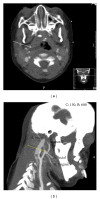Internal maxillary artery pseudoaneurysm: a near fatal complication of seemingly innocuous pharyngeal trauma
- PMID: 24826317
- PMCID: PMC4010017
- DOI: 10.1155/2011/241375
Internal maxillary artery pseudoaneurysm: a near fatal complication of seemingly innocuous pharyngeal trauma
Abstract
A 2-year-old boy presented with persistent pain and oral blood loss after falling with a toothbrush in his mouth. Initial routine inspection of the oropharynx showed no abnormalities. Recurrent blood loss instigated a reinspection under general anesthesia revealing the head of the toothbrush embedded in the nasopharynx. The toothbrush was removed without problems but several hours later a near fatal rebleeding occurred, requiring aggressive fluid resuscitation. Subsequently, the patient was transferred to our pediatric intensive care unit for further evaluation and treatment. CT angiography (CTA) showed a pseudoaneurysm of the internal maxillary artery which was successfully coiled, and further recovery was uneventful. Pediatric pharyngeal trauma is a common entity with rare, but potentially life-threatening, complications. In case of pharynx lesions, bleeding, and persistent pain, flexible endoscopy by an otolaryngologist is mandatory. In case of persistent bleeding vascular imaging is essential with CTA being a reliable alternative for the more invasive angiography.
Figures



References
-
- Hellmann JR, Shott SR, Gootee MJ. Impalement injuries of the palate in children: review of 131 cases. International Journal of Pediatric Otorhinolaryngology. 1993;26(2):157–163. - PubMed
-
- Soose RJ, Simons JP, Mandell DL. Evaluation and management of pediatric oropharyngeal trauma. Archives of Otolaryngology—Head and Neck Surgery. 2006;132(4):446–451. - PubMed
-
- Randall DA, Kang DR. Current management of penetrating injuries of the soft palate. Otolaryngology—Head and Neck Surgery. 2006;135(3):356–360. - PubMed
-
- Schoem SR, Choi SS, Zalzal GH, Grundfast KM. Management of oropharyngeal trauma in children. Archives of Otolaryngology—Head and Neck Surgery. 1997;123(12):1267–1270. - PubMed
-
- Pitner S. Carotid thrombosis due to intraoral trauma. An unusual complication of a common childhood accident. The New England Journal of Medicine. 1966;274(14):764–767. - PubMed
Publication types
LinkOut - more resources
Full Text Sources

